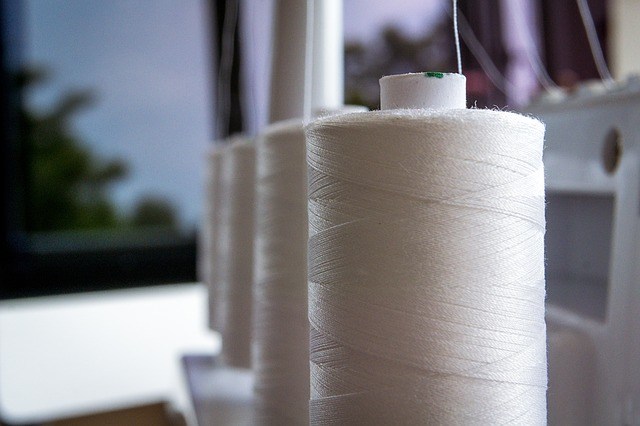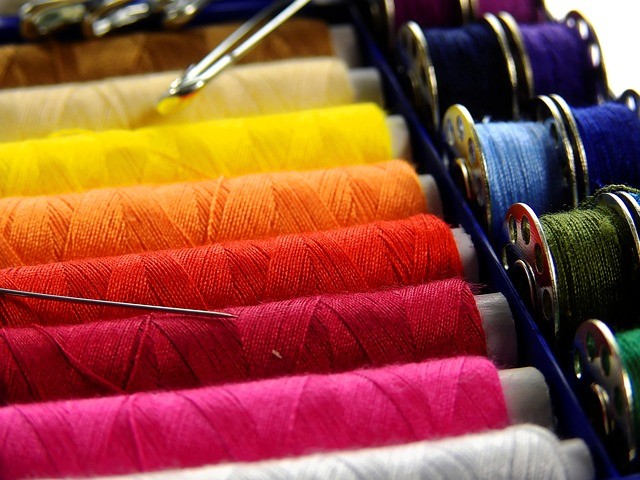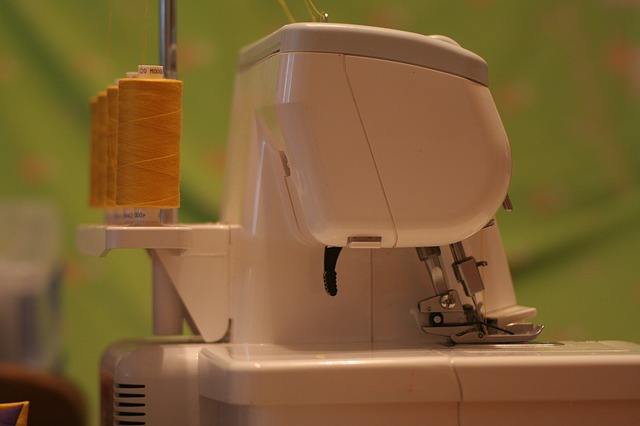Those who have been crafting and sewing long enough have no doubt seen a variety of tools available to help their jobs, but how do you know what you need to succeed?
While most home crafters know all about their reliable sewing machine, a quick cruise through your local fabric store will no doubt have displays of serger sewing machines with their tangle of threads like an overeager spider.

Do you need one? What is a serger sewing machine used for?
For that matter, what is a serger sewing machine? How much does it cost, and is it worth the investment? Let’s take a look.
Definition of a Serger Sewing Machine
A serger sewing machine is also known as an overlock machine. It is similar to a regular sewing machine, but instead of a traditional straight stitch, it binds the fabric together with an overlock stitch.
An overlock stitch is created with three or four different threads, hence all the spools on top of the machine, which make it look both regal and downright scary to behold.
As a bonus, it uses a blade to cut the fabric for you as you use it, resulting in less manual labor when making beautiful crafts.
The main reason why people would use a serger sewing machine is because it creates a very durable stitch. You will see the overlock stitch on the seams of almost any commercial clothing.
Take a look at the edge of your sleeve—you should see a stitch that has an almost honeycomb pattern on the underside. With multiple threads used to make this overlock stitch, it unravels much less easily and can handle the demands of everyday wear and multiple washes.
Most clothing companies use industrial versions of sergers when they manufacture the products you wear every day, not only because it creates such a durable stitch, but because they are fast and efficient little tools.
This sort of stitch works especially well for stretchy fabrics, and you’ll almost always see this sort of overlock stitch on your favorite pair of yoga pants or sweatshirt.
If you’re looking for an industrial touch to your blankets, clothes, or any other fabrics, then this machine brings it right home for you.
Traditional Sewing Machine vs. Serger
So why would you need both machines? Well, most of you know about a normal sewing machine—it uses a single thread and a bobbin to create a variety of stitch patterns based on the needs of your project.
Some machines may have two threads if you’re using a double needle. Most sewing machines come with a long neck and a variety of feet to use on different materials and for different purposes.
They can also help you create buttonholes, zippers, and even small embroidery patterns.
A serger, on the other hand, uses anywhere from two to five threads every time. The type of stitch is also different. A serger can only use the overlock stitch (though some more expensive machines may be able to use different stitches!).

A serger sewing machine is not able to do different functions such as buttonholes like a traditional machine. The serger, however, cuts the fabric as it binds it together, saving you a step from a normal sewing machine. It also runs much faster, has a shorter neck, and can only stitch on the left side of the needle.
For some projects, this is an important distinction, as you will not be able to turn your fabric and run it from the right side. The speed at which a serger does its job is a wonder to behold, though!
How Does a Serger Sewing Machine Work?
A serger uses three, four, or five threads to sew a seam, trim the raw edges, and finish the edges all at the same time.
Most sergers will allow you to turn off the blade function if you have a project that you don’t want cut as you go along.
As with most machines like this, the more money you spend, the more options for functions you will have.
Let’s take a look more closely at the different options of sergers available. Some machines will allow you all of these functions:
- A Two- to Four-Thread Serger: A variety of functions allows you to make a true safety stitch or a two-thread overlocked edge. Some other varieties of serger machines will not allow you to go as low as two threads. At least two threads are used in each operation, and you can use it to create each stitch separately from each other.
- A Three- to Four-Thread Serger: This machine can function with either three or four threads. A four thread stitch gives you a wider and stronger seam, but either function will give you a secure, stretchy seam. Most of these types of machines will also allow you to make a rolled hem by changing out the throat plate. When using the four thread stitch, you can make a mock safety stitch, which is similar to a regular safety stitch, but not as strong.
- A Five-Thread Serger: These machines tend to be the most expensive, but also give you the most options. You can make an overlocked edge or a straight seam line, which allows you to do more on your project without switching machines. While it still won’t completely eliminate your need for a regular sewing machine for functions like zippers, buttons, and facings, it gives you more flexibility and strength to your projects.
How Much is a Serger Sewing Machine?
Much like traditional sewing machines, a serger can range from anywhere between $100 and $5,000, depending on brand name, functions, and how durable it is.
Luckily, unless you are using it for industrial purposes, you shouldn’t have to spend more than $500 on a quality machine.
Talk to your local sales representative at your craft store or sewing machine repair center, and they’ll be sure to point you towards a good recommendation.
You could also reach out to local classes or clubs of sewers, and see what a seamstress’ favorite is. There are plenty of resources to help you get what you need, all within your budget.
As with all sewing machines, the key to getting the longest life out of your serger is to use it properly and keep it clean.
If you decide to purchase a serger, make sure you consult your owner’s manual on how to thread, clean, and store your machine.
Although they look intimidating, sergers are actually very easy to use, so with a bit of care, you can think of your serger as an investment for your future projects, rather than just another toy that will gather dust.
Once you begin to use your machine, you’ll certainly become fond of it.
Do You Need a Serger for Your Project?
Since sergers are primarily used for hemming and edging, the question really is: What is your project? If you are making clothing frequently, this machine will not only save you time, but it will make your finished project sturdier.
For example, if you were hemming a pair of pants on a traditional sewing machine, you would have to cut the fabric, make a zig-zag stitch on the bottom to prevent fraying, fold the hem, iron it in place, flip it over and iron it again, and then finally hem the bottom.

If you use a serger, however, all you have to do is serge the bottom, then fold over once and top-stitch. Notice that you still need a traditional machine to finish, unless you prefer to topstitch by hand. But the serger definitely saves you a lot of steps and creates a firmer stitch than a zig-zag on a regular machine.
A serger is especially useful with stretchy fabrics, as they are less likely to slip on this machine, and the stitches hold better.
If your projects include mostly things like quilts, bags, purses, and a lot of woven fabrics, a serger is probably not necessary.
Some quilters like using sergers, but the extra thread can make the top look lumpy. Totes and bags usually use woven fabrics, and while a serger will help prevent fraying on these materials, the stitch will not stay as strong as a regular straight seam.
Plus, most bags have the seam tucked on the inside anyway, so the threads are not exposed and don’t experience the same wear and tear as with clothing.
Overall Verdict
Now that you understand what a serger sewing machine is, how it performs, and what projects it’s best for, let’s break it down into some simpler terms.
Pros
- Much faster than a traditional sewing machine
- Stitches, cuts, and hems all at the same time
- Lots of options available for different price ranges and project needs
- Can save you a lot of time and steps when making clothing
- Overlock stitch provides a very strong and durable stitch to make your projects last longer
Cons
- Does not do other functions such as zippers and buttonholes
- You will still require a traditional sewing machine to finish almost all projects
- Is not useful for woven materials and projects such as bags and quilts
- Can be a challenge to thread and clean
- Adds another relatively large machine to your workspace
Here’s a video showing an example of a serger and its functions.
Ultimately, it comes down to what sort of projects you will be using most to know whether or not a serger would be a worthy investment, but for many crafters, it is an invaluable and time-saving tool.
Do you own a serger sewing machine? Do you recommend it?
